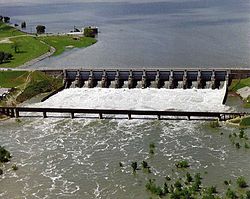| Lavon Dam | |
|---|---|
 Aerial view of Lavon Dam | |
| Country | United States |
| Location | Collin County, Texas |
| Coordinates | 33°1′57″N96°28′2″W / 33.03250°N 96.46722°W |
| Status | In use |
| Construction began | January, 1948 |
| Opening date | September 1953 |
| Construction cost | $88,351,248.00 |
| Owner(s) | The U.S. government, operated by the U.S. Army Corps of Engineers, Fort Worth District |
| Dam and spillways | |
| Type of dam | Rolled earthfill |
| Impounds | East Fork of the Trinity River |
| Height | 81 ft (25 m) |
| Length | 19,493 ft (5,941 m) |
| Width (crest) | 475.5 ft (144.9 m) |
| Dam volume | 17,055,000 cu yd (13,039,000 m3) |
| Spillway type | Ogee crest |
| Spillway capacity | 1,507,000 cu ft/s (42,700 m3/s) |
| Reservoir | |
| Creates | Lavon Reservoir |
| Total capacity | 409,360 acre⋅ft (0.50494 km3) |
| Surface area | 20,559 acres (8,320 ha) |
Lavon Dam is located in Collin County, Texas on the East Fork [1] of the Trinity River, about 3 miles east of Wylie and 22 miles northeast of Dallas. It was constructed to create the Lavon Lake and is named after the town of Lavon. Dams are generally named after the closest town near the structure. [2]